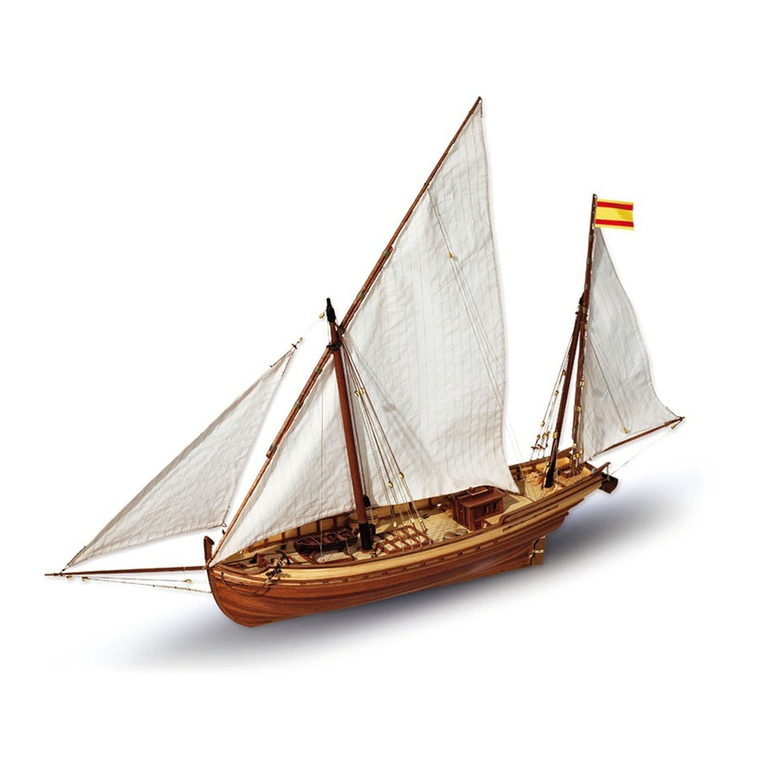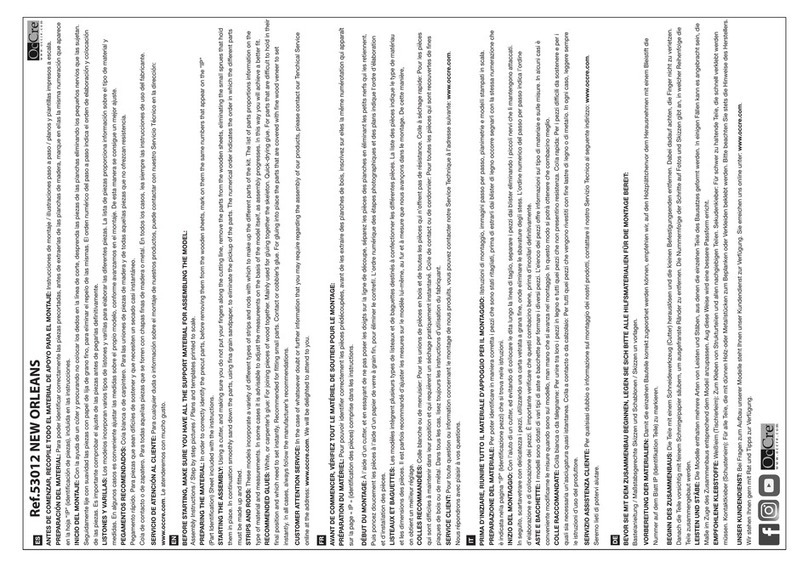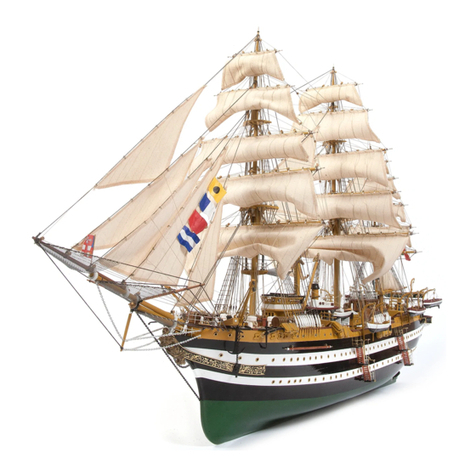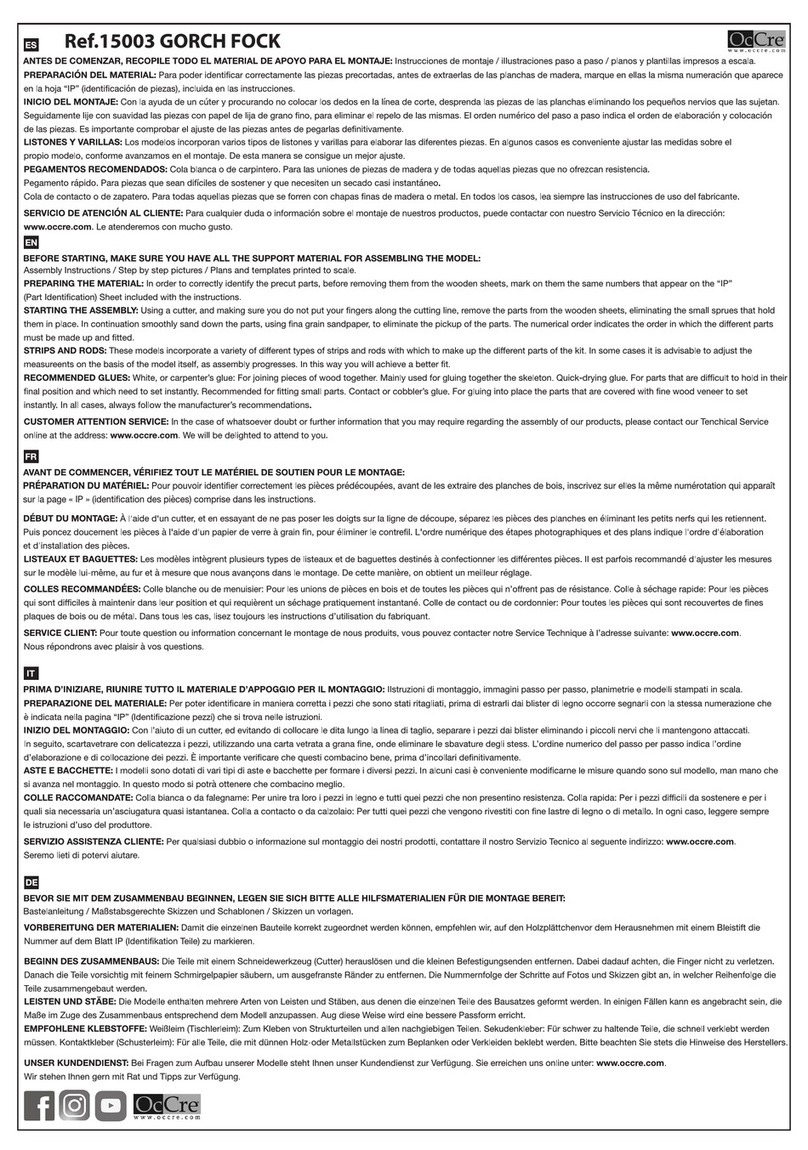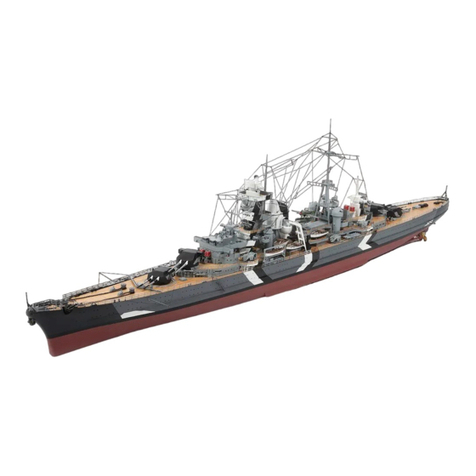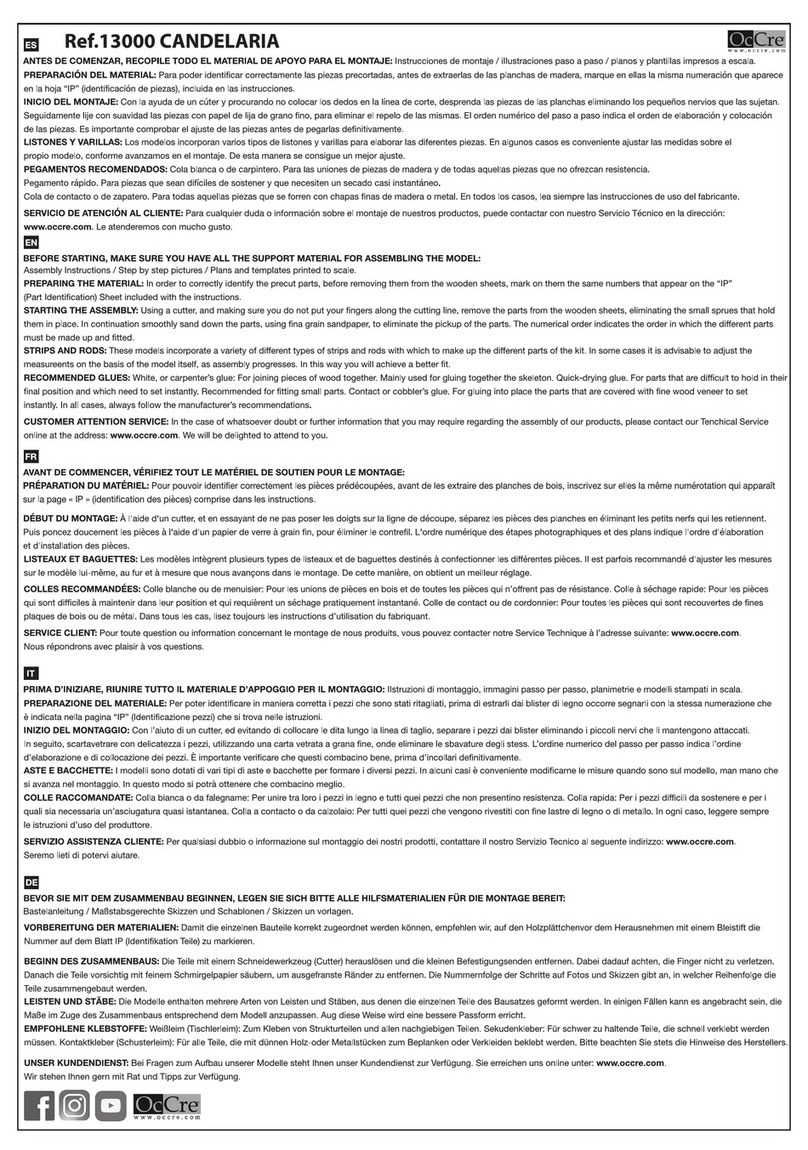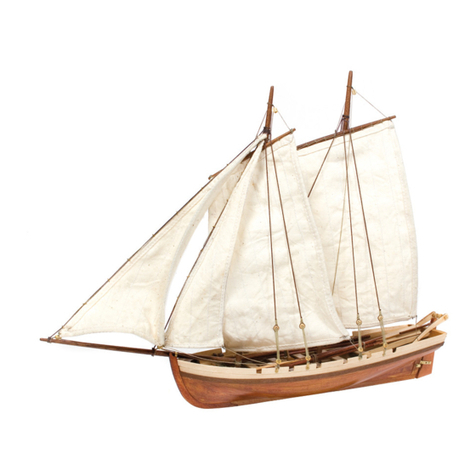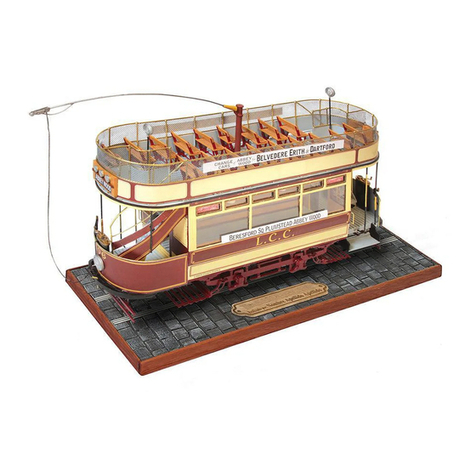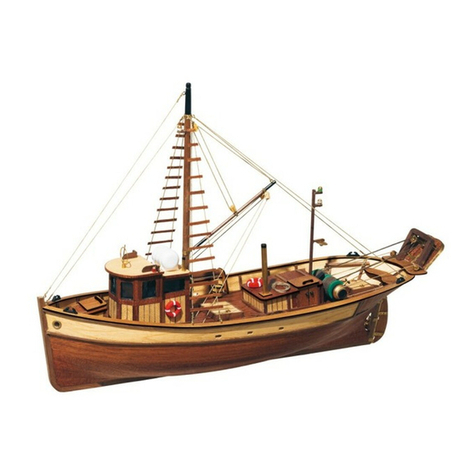INSTRUCTIONS DE MONTAGE ULISES R-C
COQUE
PHOTO 1. Prendre les trois morceaux de quille 1, 2et 3. Les unir et fixer l’union aux renforts 4au milieu de la proue et aux renforts 5
au milieu de la poupe (un de chaque côté). Ils doivent être de niveau avec la partie supérieure de la quille. Cette opération doit être
réalisée sur une surface plane.
À la poupe, coller les renforts 6en veillant à ce qu’ils soient de niveau avec la partie supérieure et que leurs rainures soient alignées sur
celles de la fausse quille.
Ensuite, coller les couples 7à 18. Mais, avant de les coller, vérifier qu’ils s’emboîtent correctement à leur place et qu’ils pénètrent à
fond dans les emboîtures de la fausse quille. Il est important que les couples soient parfaitement perpendiculaires à la fausse quille.
Enfin, coller l’appui pour le mât 19 sur la fausse quille de proue 1. Utiliser de la colle blanche (colle de menuisier) pour réaliser cette
opération.
Mettre de côté les pièces 65 et 66, qui se trouvent à côté de ces pièces, de sorte à les utiliser plus loin dans le montage.
PHOTO 2. À la proue, coller les renforts 20 de chaque côté de la fausse quille en veillant à ce qu’ils ne dépassent pas la partie
supérieure de celle-ci. Utiliser de la colle blanche.
PHOTOS 3 – 5. Prendre les baux des couples 21 à 27 et les placer chacun dans son couple correspondant. Observer que les
emboîtures que présentent les couples 26 et 27 doivent se trouver du côté tribord (droit) de la coque. La base du moteur 28 sera placée
dans la zone de poupe sur la fausse quille et sur le couple 14. Utiliser de la colle blanche.
PHOTO 6. Prendre la base du servo 29 et la poser sur les emboîtures que présentent les baux des couples de poupe. La petite
emboîture située sur la partie intérieure de la base doit être orientée vers la proue de la coque.
PHOTOS 7 – 9. Coller ensuite les renforts longitudinaux 30, 31 et 32. Les renforts 30 dans la zone de proue, les renforts 31 dans la
zone intermédiaire et les renforts 32 dans la zone de poupe.
PHOTO 10. À la proue, coller le pont 33. Veiller à ce que le pont ait un bon contact avec la partie supérieure des couples.
PHOTOS 11 – 13. Coller les deux renforts 34 sous ce pont. Ceux-ci permettront de clouer par la suite les virures. Emboîter et coller le
pont 35 à la poupe. Coller les renforts 36 sous ce pont.
PHOTOS 14 – 15. Afin d’obtenir une bonne superficie de contact pour les virures 37, dégrossir à l’aide d’une ponceuse ou d’une lime
l’arête des couples dans le sens proue-poupe. Ces opérations doivent être répétées de chaque côté de la coque.
Poursuivre le limage tout le long de la coque. On ajustera également le profil des ponts afin que les murailles 51 et 52 s’emboîtent
convenablement par la suite. Limer également à la poupe dans le sens poupe-proue. Appliquer au pinceau de la colle diluée dans 10
pour cent d’eau sur toutes les unions afin de renforcer l’ensemble.
PHOTOS 16 – 17. Le bordé de la coque doit être réalisé par morceaux. À cet effet, mesurer la zone que couvre une virure 37 à la
proue, coller les zones de contact et clouer la virure. Il faut veiller à ne pas recouvrir les emboîtures situées sur la partie supérieure de
tous les couples (environ 3 mm). Ceci permettra de prévoir un espace pour fixer les murailles 51 et 52.
PHOTOS 18 – 22. Placer le bout de la première virure de sorte qu’elle ne couvre que la moitié de l’épaisseur du couple sur lequel elle
repose. On peut utiliser une colle à séchage rapide ou une pointe pour la fixer dans cette position. Les morceaux de virure sont placés
les uns à la suite des autres et occupent l’espace qui a été réservé pour le premier morceau. Procéder ainsi jusqu’à ce que la poupe de
la coque soit recouverte. Répéter cette opération de part et d’autre de la coque afin de maintenir l’ensemble bien aligné.
PHOTO 23. On a commencé le bordage sur la partie supérieure de la coque, mais il faut également couvrir la partie inférieure en allant
vers la zone du pont. Toutes les virures doivent également être unies latéralement avec de la colle. Appliquer à nouveau de la colle au
pinceau par l’intérieur au fur et à mesure qu’on recouvre la coque. On obtiendra ainsi un montage parfaitement colmaté et renforcé.
PHOTO 24. L’union des virures ne doit jamais coïncider sur le même couple. C’est à cette fin qu’il faut alterner la position de l’union des
virures sur les couples.
PHOTOS 25 – 26. Observer le détail de la poupe où l’on peut voir que les virures arrivent jusqu’à la partie centrale de la fausse quille.
PHOTOS 27 – 29. Pour obturer les petites ouvertures qui pourraient subsister à la poupe, utiliser de petites cales fabriquées avec des
morceaux de virure. Au fur et à mesure qu’on recouvre la coque, on colmatera les ouvertures qui subsistent en utilisant des coins
(virures affilées aux deux extrémités). L’arête de la fausse quille doit être libre. Lorsque le bordage est terminé, limer les têtes des
pointes avec une lime et poncer toute la coque de sorte à obtenir une surface lisse et uniforme.
PHOTOS 30 – 31. Percer l’orifice dans lequel seront introduits le tube et l’arbre de l’hélice. L’orifice d’entrée est marqué sur la fausse
quille. Réaliser cette opération jusqu’à ce qu’on atteigne l’intérieur de la coque. Si on le préfère, on peut attendre d’avoir le tube pour
faire cette opération avec plus de précision. Le diamètre du foret doit être de 12 mm ; on l’ajustera ensuite au diamètre du tube quand
on l’installera.
PHOTO 32. Avant d’appliquer un vernis sur tout l’intérieur, appliquer au pinceau de la colle diluée dans 10 pour cent d’eau sur tout
l’intérieur de la coque. Ceci scellera et renforcera la coque. Lorsqu’elle sera sèche, on appliquera un vernis afin de protéger tout
l’intérieur et de l’imperméabiliser. On peut appliquer un vernis nautique ou pour sols en bois.
PHOTO 33.Appliquer de la colle sur tous les baux des couples et placer les ponts 38 et 39. Ces ponts doivent bien s’assembler contre
les baux. Avant de placer le pont 39, retirer et mettre de côté le couvercle 40 qui sera utilisé lors de phases ultérieures de montage.
PHOTOS 34 – 37. Emboîter et coller la cloison 41 et les appuis 42 et 43 dans les encoches correspondantes. Coller le pont 44 sur ces
dernières. Retirer le couvercle 45 et le conserver pour des phases ultérieures de montage. Lorsque l’ensemble sera sec, réaliser un
ponçage latéral pour que les arêtes des appuis soit de niveau avec le profil des ponts. Effectuer également un ponçage de haut en bas
afin de donner une inclinaison aux ponts.
PHOTOS 38 – 40. Le ponçage réalisé à l’étape précédente permettra de couvrir toute la zone à l’aide de morceaux de virure 46.
Commencer le bordage en partant de la cloison et laisser libre l’épaisseur de celle-ci afin d’y appuyer plus tard les murailles. On peut
utiliser de la colle à prise rapide.
PHOTO 41. Lorsqu’elle sera sèche, poncer cette pièce afin d’éliminer les morceaux de listeaux qui dépassent au-dessus du pont.
Poncer également pour niveler l’union entre ces listeaux et ceux du bordé de la coque.
PHOTO 42. Prendre les pièces 47, 48 et 49. Coller et emboîter ces pièces sur le pont de proue comme sur la photo. Effectuer un
ponçage de sorte que les côtés s’ajustent au périmètre du pont inférieur.
PHOTOS 43 – 45. Commencer le bordage des ponts en utilisant les plaques 50. Placer un premier morceau sur la partie intermédiaire
du pont. Placer de chaque côté des morceaux de 70 mm, puis, à la suite de ceux-ci, un autre morceau de sorte à atteindre l’espace
vide de l’écoutille. Placer de chaque côté d’autres bandes longues comme la bande centrale. Alterner les pièces de sorte que l’union ne
coïncide pas avec l’union contiguë. Compléter le reste avec des bandes coupées à une dimension d’environ 140 mm. Utiliser de la colle
